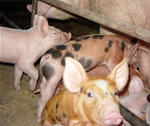Pigtrop - Le centre d'information sur l'élevage porcin et les filières porcines des pays du Sud
- Lutte contre les maladies
- Alimentation adaptée
- Stratégies génétiques
- Protection des ressources naturelles
- Socio-économie de la filière porcine
- Risque alimentaire et qualité sanitaire
- Techniques d'élevage
- Développement rural
Instituto de Investigaciones Agropecuarias y Forestales, Universidad Michoacana de San Nicolás de Hidalgo, km 9.5, carretera Morelia - Zinápecuaro, municipio de Tarímbaro, Michoacán
*Instituto de Investigaciones Agropecuarias y Forestales, Universidad Michoacana de San Nicolás de Hidalgo, km 9.5, carretera Morelia - Zinápecuaro, municipio de Tarímbaro, Michoacán
** Facultad de Medicina Veterinaria y Zootecnia, Universidad Autónoma de Yucatán. Km 15.5 carretera Mérida-Xmatkuil, Mérida, Yucatán
Hormones in lactating sows | Selection of the best model for the analysis of experiments with repeated measurements over time
The objective of this study was to determine the effect of different covariance structures on the statistical significance and on the fixed effect estimates, using as an example the data of four hormones in a repeated measures experiment.
Abstract
The objective of this study was to determine the effect of different covariance structures on the statistical significance and on the fixed effect estimates, using as an example the data of four hormones in a repeated measures experiment. The study was carried out in a three-sites commercial farm with 2400 sows in La Piedad Michoacan, Mexico. Thirty-two multiparous sows from three genetic groups (11 AZ, 11 B and 10 N sows) were used. Sows were bled and a 10 ml blood sample was taken to determine the concentration of progesterone (P4), estradiol (E2), prolactin (PRL) and insulin (INS). Blood samples were taken at days 3, 6, 9, 12 and 15 of lactation. Hormone assays were carried out by radioimmunoanalysis. Data were analyzed using anova repeated measures and mixed models procedures. The anova repeated analysis was carried out using the options RANDOM and TEST of the SAS programme. The mixed models considered nine covariance structures: variance components (VC), compound symmetry (CS), autoregressive (AR(1)), Toeplitz, unstructured (UN), heterogeneous CS (CSH), heterogeneous AR(1) and heterogeneous Toeplitz.
The anova repeated analysis gave similar results than the CS structure. The best covariance structures that described the data were ANTE(1), UN, CS and CS for P4, E2, PRL and INS, respectively. Differences were observed in the levels of significance of the fixed effects, mainly of genetic group, depending on the structure used. For example, for P4 the interval of significances for genetic group was from P = 0.0063 for the structure CV to P = 0.1318 for Toeplitz. The effect of time of lactation on the hormone concentrations was highly significant for all structures (P<0.001). The generalized least squares means and standard errors (SE), were also affected by the type of the covariance matrix. For P4 the lowest SE corresponded to the simplest structure (VC) and the greatest to the AR(1) and Toeplitz structures.
In conclusion, the results of this study indicate that the covariance structure selected affects the level of significance of the F test and the SE of the means. The analysis of the data for the hormones here studied but with different bleeding times or for shorter or longer periods, as well as the study of other response variables needs the exploration of different covariance structures in order to find the most appropriate.
Key words
Covariance structures, hormones, mixed models, repeated measures
Source
Commentaires
CIRAD © 2007 (Tous droits réservés) - Informations légales - Page mise à jour : 09/05/2007
